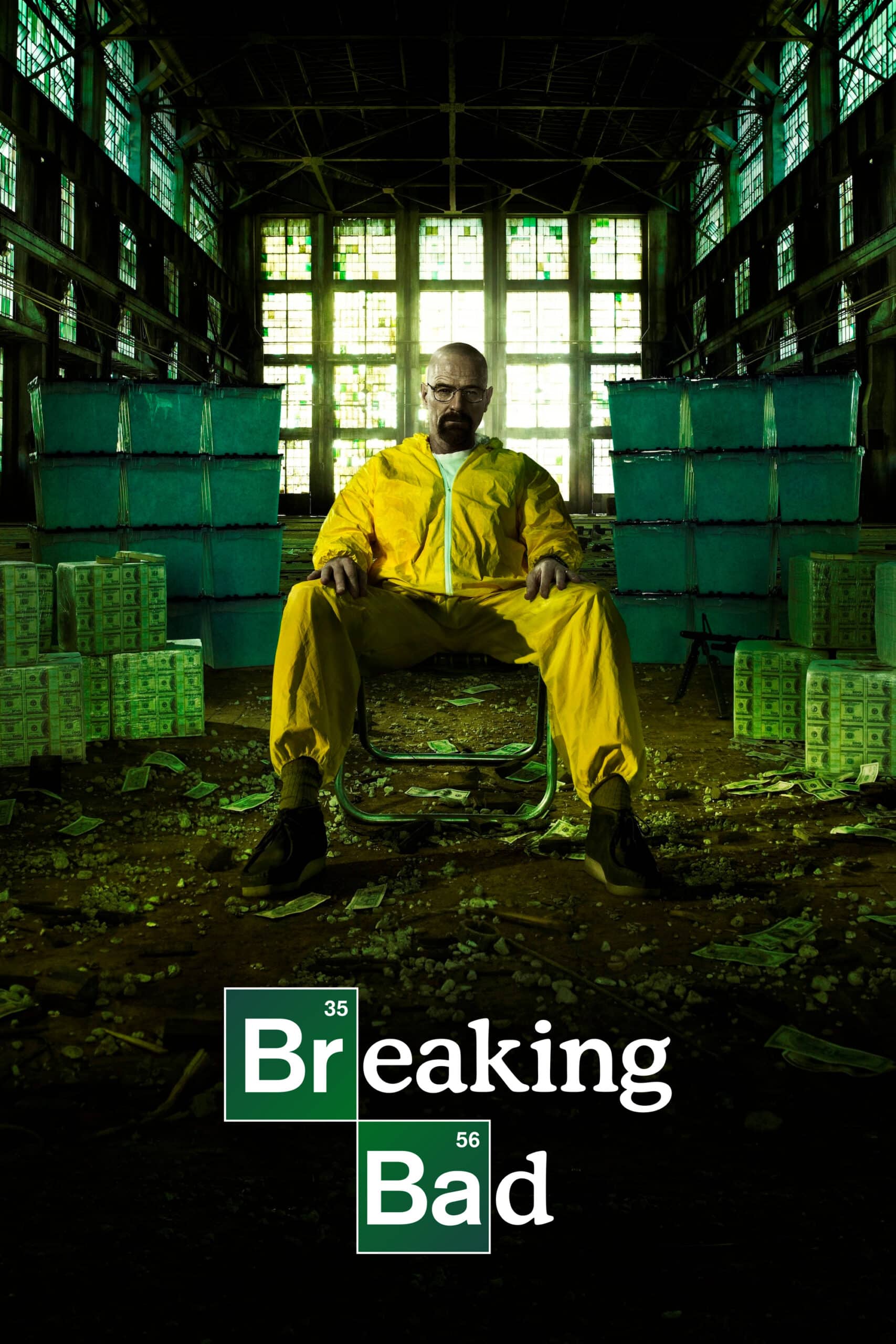


Breaking Bad revolutionized television drama when it premiered on January 20, 2008, transforming the medium through morally complex storytelling and unprecedented character development. This crime/drama/thriller masterpiece holds an exceptional 9.5/10 IMDb rating from over 2.1 million votes, cementing its status as one of the greatest television series ever created.
Vince Gilligan's visionary creation follows high school chemistry teacher Walter White's transformation into ruthless drug kingpin Heisenberg across five seasons and 62 episodes. Breaking Bad cast features career-defining performances that elevated television acting to cinematic heights, proving that serialized storytelling could achieve artistic legitimacy rivaling prestige cinema.
Breaking Bad cast brilliance begins with Bryan Cranston's transformative portrayal of Walter White. The actor, previously known for comedic roles, delivered a performance of staggering range—from meek chemistry teacher to calculating criminal mastermind. Cranston won four Emmy Awards for Outstanding Lead Actor, demonstrating the character's complexity across the series' five-season run.
Walter White Breaking Bad Heisenberg evolution represents television's most compelling character transformation. The series methodically charts Walt's descent from sympathetic cancer patient to moral monster, with each season peeling away another layer of rationalization until only naked ambition remains. Cranston's ability to maintain viewer engagement despite his character's increasingly reprehensible actions showcases extraordinary acting skill.
Aaron Paul's Jesse Pinkman evolved from planned early-season death to series co-lead through the actor's emotionally devastating performance. Paul won three Emmy Awards for Outstanding Supporting Actor, creating a character whose moral struggle provided counterpoint to Walt's corruption. Jesse Breaking Bad journey from small-time dealer to tormented accomplice generates the series' emotional core.
The Jesse and Walt dynamic drives Breaking Bad's narrative engine. Their twisted father-son relationship—Walt manipulating Jesse's loyalty while destroying his soul—creates tragic tension that propels the series toward its inevitable conclusion. Paul's raw vulnerability balances Cranston's calculated menace throughout the 62-episode run.
Breaking Bad characters showcase depth rarely achieved in television. Anna Gunn's Skyler White transforms from passive spouse to active participant in Walt's criminality, with Gunn winning two Emmy Awards for the nuanced portrayal. Dean Norris' Hank Schrader provides law enforcement perspective, his DEA agent unknowingly pursuing his brother-in-law across multiple seasons.
Gus Fring Breaking Bad antagonist, portrayed by Giancarlo Esposito, introduced one of television's most chilling villains. The mild-mannered chicken restaurant owner concealing ruthless drug empire created unforgettable tension. Esposito's contained performance—barely suppressed rage beneath polite facade—influenced countless subsequent television antagonists.
Mike Breaking Bad character, played by Jonathan Banks, exemplifies the series' attention to supporting role development. The ex-cop turned criminal fixer receives thorough backstory and moral code that makes his eventual fate emotionally devastating. Banks earned two Emmy nominations for creating a character memorable enough to anchor spinoff "Better Call Saul."
Jane from Breaking Bad, portrayed by Krysten Ritter, demonstrates how brief appearances can generate lasting impact. Her relationship with Jesse and tragic death in Season 2 catalyze major plot developments while examining addiction's human cost. The series refuses simplistic moral judgments, presenting each character as flawed human rather than archetypal good or evil.
How many seasons of Breaking Bad are there—the complete series spans five seasons totaling 62 episodes. The show's structure demonstrates meticulous planning, with each season escalating stakes while deepening character complexity:
Season 1 (7 episodes): Walt's cancer diagnosis and entry into methamphetamine production with Jesse. The shortened first season due to the 2007-2008 Writers Guild strike actually benefited pacing, creating intense narrative compression.
Season 2 (13 episodes): Walt and Jesse's operation expands, introducing Saul Goodman and culminating in the devastating plane crash resulting from Walt's indirect actions. The season's pink teddy bear motif demonstrates the series' sophisticated visual storytelling.
Breaking Bad Season 3 (13 episodes): The Cousins hunting Walt, Jesse's downward spiral, and the introduction of Gus Fring as major antagonist. The season builds toward the explosive confrontation between Walt and Gus's operation.
Breaking Bad Season 4 (13 episodes): Walt's psychological chess match with Gus, featuring the iconic "I am the one who knocks" speech and Gus's spectacular demise. Many consider this the series' peak in terms of sustained tension.
Breaking Bad Season 5 (16 episodes): The final season split into two parts—5A showing Walt's empire at its height, 5B depicting his inevitable downfall. The series finale "Felina" provided satisfying closure while maintaining thematic integrity.
Breaking Bad episodes consistently ranked among television's finest, with multiple installments receiving perfect scores from critics. "Ozymandias" (Season 5, Episode 14) holds a 10/10 rating on IMDb from over 150,000 votes, widely considered one of the greatest television episodes ever produced.
The series mastered cold opens that seemed disconnected before revealing devastating relevance. Season 2's black-and-white flash-forwards to the plane crash aftermath created mystery while foreshadowing Walt's destructive impact. These structural innovations influenced subsequent prestige television.
Breaking Bad TV series episodes typically run 47-48 minutes, allowing thorough character development while maintaining narrative momentum. The series avoids typical procedural structure, instead building season-long arcs with careful attention to cause and effect. Every action generates consequences that ripple across multiple episodes.
The show's patience in developing situations—spending entire episodes on single events like the fly in the superlab or Jesse's captivity—demonstrates confidence in storytelling that prioritizes character over plot convenience. This approach rewards attentive viewing while building unbearable tension.
Where to watch Breaking Bad options include multiple streaming platforms offering the complete series in high definition. Where can I stream Breaking Bad through premium IPTV services that provide superior viewing quality, showcasing the show's cinematic cinematography and meticulous production design across all 62 episodes.
The series benefits from binge-watching that allows viewers to appreciate long-form narrative construction impossible in week-to-week viewing. Subtle callbacks and visual motifs become apparent when episodes flow consecutively, revealing the writers' meticulous planning across five seasons.
Available Viewing Options:
Heisenberg Bad Breaking persona represents Walt's id unleashed—the ruthless, capable man he believes existed beneath his underachieving exterior. The name, borrowed from physicist Werner Heisenberg's Uncertainty Principle, suggests the impossibility of truly knowing Walt's nature. The character becomes increasingly dominant as the series progresses, with Walt the teacher disappearing beneath Heisenberg the kingpin.
The physical transformation reinforces psychological change. Walt's shaved head, black clothing, and porkpie hat create intimidating visual presence contrasting sharply with the khaki-wearing chemistry teacher. Cranston's posture and voice shift when Walt adopts the Heisenberg persona, demonstrating how completely the character embraces his criminal identity.
Walt's Season 4 declaration to Skyler—"I am not in danger, Skyler. I am the danger. A guy opens his door and gets shot, and you think that of me? No. I am the one who knocks!"—crystallizes his complete transformation. The speech reveals Walt's delusion that he controls circumstances rather than being controlled by pride and ambition.
Breaking Bad Season 5 Series divided into two eight-episode parts aired a year apart, building anticipation for the series conclusion. The first half shows Walt's empire reaching its peak with his "out" seemingly achieved. The second half depicts the inevitable collapse as past actions generate inescapable consequences.
The season's structure mirrors the entire series' rise and fall pattern compressed into sixteen episodes. Walt's attempt to leave the drug trade fails because Heisenberg cannot accept anything less than total victory—the pride that drove his initial descent ensures his ultimate destruction.
How does Breaking Bad end—the series finale "Felina" provides closure while maintaining thematic consistency. Walt's final actions demonstrate that even at the end, he cannot fully acknowledge his true motivations. His admission to Skyler—"I did it for me. I liked it. I was good at it. And I was really... I was alive"—represents the series' most honest moment.
The ending allows Walt one last display of Heisenberg's capabilities while ensuring appropriate consequences. His death in the meth lab surrounded by equipment represents poetic justice—the chemistry that gave him power ultimately destroys him. Jesse's escape provides hopeful counterpoint, suggesting redemption remains possible for those genuinely seeking it.
Breaking Bad won 16 Primetime Emmy Awards from 58 nominations, including Outstanding Drama Series twice. The show's critical reputation grew with each season, culminating in near-universal acclaim for the final episodes. Breaking Bad cast members collected multiple awards, with Bryan Cranston and Aaron Paul dominating their respective categories.
The series finale drew 10.3 million viewers, nearly quadruple the series average, demonstrating how word-of-mouth and streaming availability built audience across its run. The show became AMC's highest-rated series and launched the network as prestige television destination alongside "Mad Men."
Breaking Bad influenced subsequent television by proving that complex antiheroes could sustain five-season narratives while maintaining quality. The series demonstrated that cable television could compete with premium networks in production values and storytelling sophistication. Shows like "Better Call Saul," "Ozark," and "Succession" owe debt to Breaking Bad's character-driven approach.
"Better Call Saul," the prequel/sequel series, expands Breaking Bad's universe while maintaining quality. Bob Odenkirk's Saul Goodman receives thorough backstory, with the series exploring how Jimmy McGill transforms into the criminal lawyer. The show features Breaking Bad characters in different contexts, enriching the original series through new perspective.
The success of "Better Call Saul" and the film "El Camino: A Breaking Bad Movie" demonstrates the universe's depth. These extensions provide closure for characters while exploring themes the original series introduced. Breaking Bad created fictional world substantial enough to support multiple narratives without diminishing the original's impact.
Breaking Bad's visual style distinguishes it from typical television drama. Cinematographer Michael Slovis employed wide-angle lenses, unusual camera angles, and vibrant color palette that gave the series cinematic quality. The New Mexico setting's harsh beauty contrasts with the ugly moral choices, with desert vistas appearing both stunning and unforgiving.
The series uses color symbolically throughout its run—Walt's green clothing in early seasons representing greed and ambition, Skyler's blue suggesting loyalty and sadness, Jesse's yellow and red reflecting his emotional volatility. These visual motifs reward attentive viewing while operating subconsciously on casual viewers.
Breaking Bad pioneered unusual camera placements that became series signatures. POV shots from inside washing machines, car trunks, and chemical containers create visceral viewing experience. Time-lapse sequences showing meth cooking or evidence disposal demonstrate meticulous process while advancing narrative efficiently.
Creator Vince Gilligan conceived Breaking Bad as "Mr. Chips becomes Scarface"—a good man transformed into villain. The series maintains this concept while adding moral complexity that prevents simplistic interpretation. Gilligan's writers room operated collaboratively, with season arcs planned meticulously before filming began.
The decision to set the series in Albuquerque, New Mexico provided visual distinctiveness while offering production incentives. The location became character itself, with the desert's isolation reflecting Walt's emotional detachment. Local architecture and landscape influenced narrative choices throughout five seasons.
Breaking Bad production faced numerous challenges, from limited budget in early seasons to maintaining quality across long shooting schedule. The writers' ability to incorporate production limitations into narrative—Season 1's shortened length, working around Aaron Paul's other commitments—demonstrates creative problem-solving.
The series finale's production coincided with Bryan Cranston's Broadway obligations, requiring careful scheduling. The show wrapped production having told exactly the story intended, with Gilligan resisting network pressure to extend beyond the planned endpoint. This artistic integrity contributed to the series' enduring reputation.
Breaking Bad transcends its crime/drama/thriller category to become essential television that rewards multiple viewings across its complete 62-episode run. The series' examination of pride, morality, and consequences remains powerfully relevant while showcasing storytelling excellence that established new standards for prestige television.
Whether experiencing this masterpiece for the first time or revisiting its tragic brilliance, Breaking Bad streaming through premium IPTV services ensures optimal viewing quality that honors Vince Gilligan's artistic vision and the extraordinary performances that define this cultural landmark.
Breaking Bad stands as proof that television drama can achieve both popular success and artistic legitimacy, creating lasting impact through morally complex characters, meticulous plotting, and visual sophistication. This transformative series continues influencing television while providing audiences with an unforgettable examination of how good people justify becoming bad.
(for customer service and support)
(for new customers)